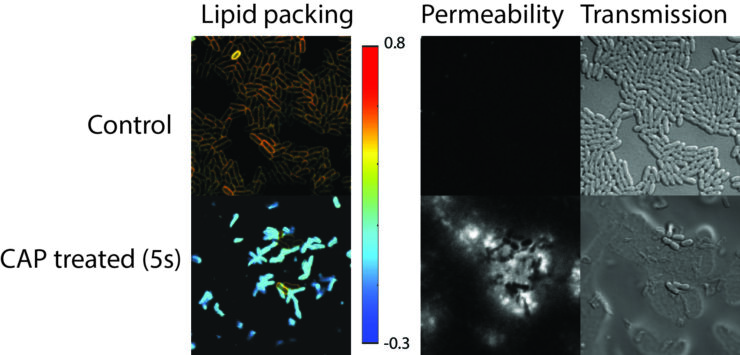Bacterial infections
Treatment of bacterial infections with cold atmospheric plasma
After a prediction by the WHO, antibiotic resistance will be one of the leading causes of death by 2050. Working alternatives besides classic antibiotherapy are therefore urgently needed. In first clinical trials it was observed that CAP efficiently destroys multi-resistant bacteria, spores and biofilms and can be applied without too much side effects onto the skin. As an alternative to classic antibiotics and antiseptics, CAP would have the advantage that it can flow into crevices of porous material, and could therefore be used in complicated wounds or tooth infections.
CAP is a multicomponent system containing multiple reactive species such as superheated electrons, ionized and non ionized gas, UV and visible light, electric fields and reactive oxygen and nitrogen species (RONS, Fig.1). The chances to develop natural resistances toward all CAP components would therefore be very low.

Figure 1 CAP produced by a plasma pen is a modulatable multicomponent system
In addition, the cocktail of the reactive species produced by a plasma pen can be modulated by changing the vector gas, the sheath gas, the potential and the frequency (Fig. 1). This could potentially be used to increase efficiency towards certain bacterial species. Unfortunately, the details of the antibiotic mechanisms of CAP on different species are lacking, preventing hence a rationale modulation of CAPs.

Figure 2 CAP treatment of bacteria reduces lipid packing and increases permeability in a drastic manner
In our group, we hence investigate the effects of CAP on bacteria, model membranes and eukaryotic cells with the aim to understand the mechanisms behind their activity. We especially focus on the effects on bacterial membranes by using biophysical, biochemical, analytical and bioinformatic approaches (Fig. 2). By understanding the detailed mechanisms, we aim to increase the efficiency/selectivity of plasmas towards bacteria by varying different parameters such as the frequency, the potential or the vector gas. Our final goal is to make plasma a working alternative for antibiotic treatment.
The main researcher involved in this project are Eefjan Breukink, Jos van Strijp and Joseph Lorent

